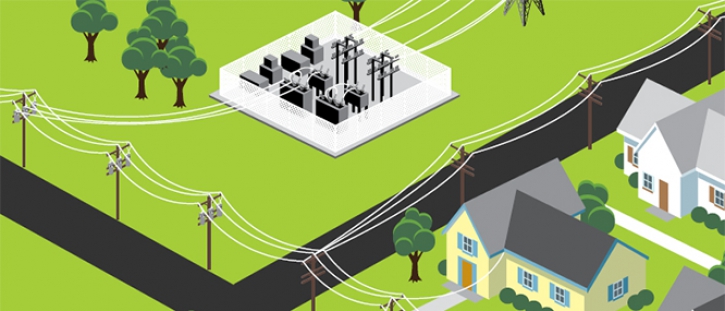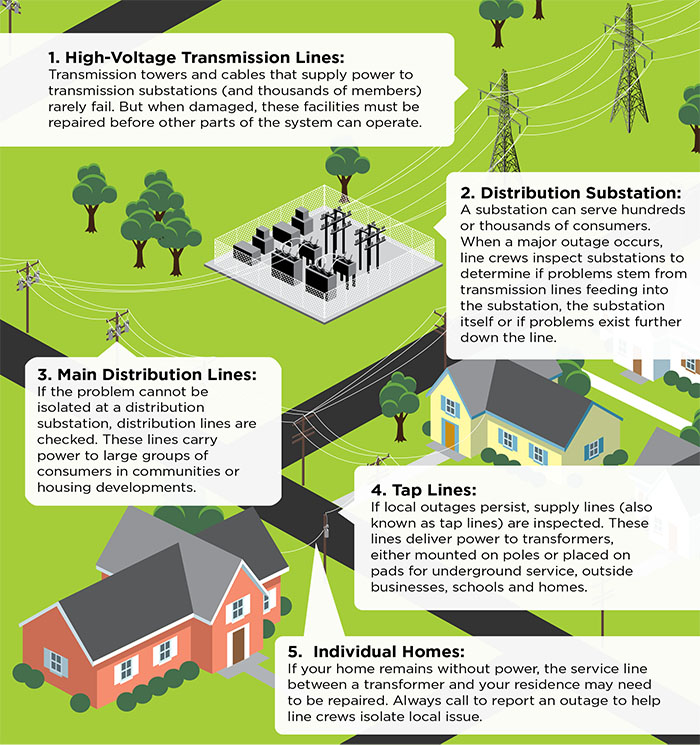The Co-op Community that Keeps Your Lights On

When a big storm knocks out power for you and your neighbors, our goal is to get your service back on as soon as safely possible. Sometimes, that means we ask for help from other electric co-ops.
Our ability to get the lights back on safely and as soon as possible comes from a combination of a centuries-old co-op tradition, the latest in weather-forecasting technology, a contract between electric cooperatives and municipal utilities and lineworkers’ spirit of dedication, pride and adventure.
When a power outage is caused by an especially severe natural disaster, the devastation can be more than the local electric co-op can quickly repair on its own. That’s when other co-ops swoop in, from next door and, sometimes, from other states.
Perhaps you’ve seen them. They arrive in caravans of utility vehicles with military-like precision as part of a plan called a “Mutual Aid Agreement.”
The origins of the Mutual Aid Agreement can be traced back to 1844, even before there were electric utilities, when the first formally organized cooperative created a set of operating principles that included “Cooperation Among Cooperatives.”
When electric co-ops were formed in the 1930s, they used that handshake-style working arrangement to help each other with repairs after severe storm damage. But in the early 1990s, the Federal Emergency Management Agency (FEMA) requested a more legalistic accounting for the aid it provided electric cooperatives after natural disasters.
So electric co-ops, represented by the National Rural Electric Cooperative Association (NRECA), got together with FEMA and the organization for city-owned utilities, the American Public Power Association, and produced a stunningly short contract — it’s exactly one page long. The contract says when one co-op goes to help another, it will charge reasonable rates for the crews and equipment.
A contract is one thing, but success means carrying it out effectively. To that end, electric co-ops rely on their decades of experience. We share that experience with each other, and we meet regularly to keep procedures updated.
The response to your power outage can start days before it even happens, with co-ops tracking weather patterns that could knock down poles. Co-ops organize under statewide associations, planning for how many line crews might be needed and where they will come from and even making hotel reservations to house crews.
In addition to the careful planning and procedures, there’s another secret ingredient to how co-ops come together in a crisis so effectively — the lineworkers. When they head out to a storm-ravaged area, it’s with a serious kind of excitement as they get ready to use their skills for a cause they passionately believe in — restoring electricity.
Let’s hope we don’t have any big storms this winter or throughout the new year. But, if we do, we will be ready to keep the lights on for you.
Powering Up After an Outage
When the power goes out, we expect it to be restored within a few hours. But when a major storm or natural disaster causes widespread damage, extended outages may result. Our line crews work long, hard hours to restore service safely to the greatest number of consumers in the shortest time possible. Here’s what’s going on if you find yourself in the dark:

1. High-Voltage Transmission Lines:
Transmission towers and cables that supply power to transmission substations (and thousands of members) rarely fail. But when damaged, these facilities must be repaired before other parts of the system can operate.
2. Distribution Substation:
A substation can serve hundreds or thousands of consumers. When a major outage occurs, line crews inspect substations to determine if problems stem from transmission lines feeding into the substation, the substation itself or if problems exist further down the line.
3. Main Distribution Lines:
If the problem cannot be isolated at a distribution substation, distribution lines are checked. These lines carry power to large groups of consumers in communities or housing developments.
4. Tap Lines:
If local outages persist, supply lines (also known as tap lines) are inspected. These lines deliver power to transformers, either mounted on poles or placed on pads for underground service, outside businesses, schools and homes.
5. Individual Homes:
If your home remains without power, the service line between a transformer and your residence may need to be repaired. Always call to report an outage to help line crews isolate local issue.
